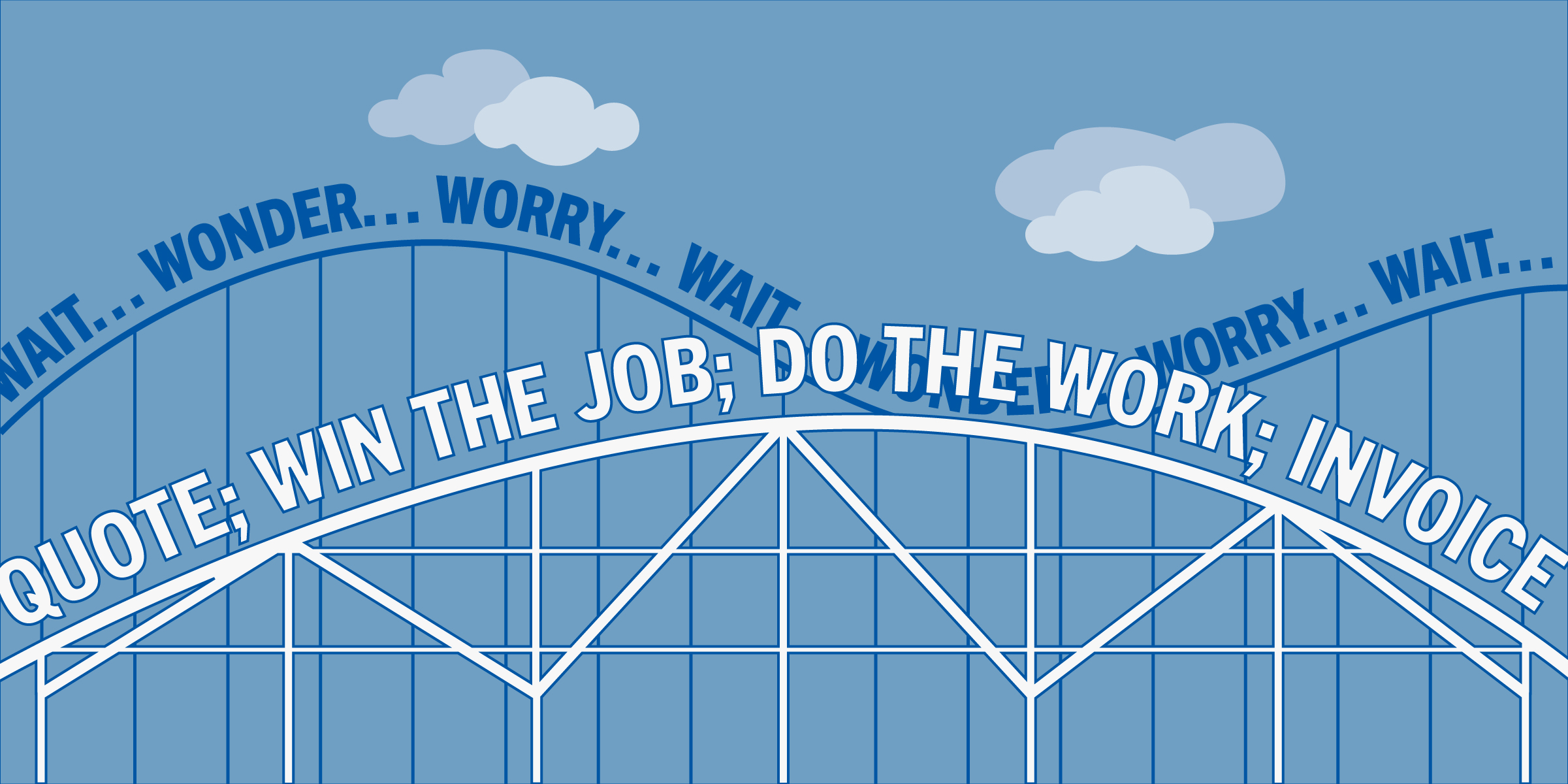


7 January 2019
Builder, plumber, painter, sparky – we’re all guilty of it. When the work’s rolling in, we knuckle down and get it done. But how much time do we actually spend getting back to new customers, following up on quotes or lining up future jobs? As much we should?
Probably not. Which is why work can so often swing from super busy to deathly quiet. Had enough of the rollercoaster? Here’s how to get off…
Working in the trades means customers often come to us for one big job, rather than lots of repeat business. Which means however hard we’re working right now, we’ve got to keep an eye out for the next customer too.
A few years ago I realised I just wasn’t doing this well enough, so I sat down with the boss (ok, the wife) and drew up a workflow of everything that needed to happen to turn a new customer call into a live, on-site, sleeves-rolled-up job.
We planned exactly how long we’d leave it between sending a quote and following it up, what we’d say when we did, and how we’d keep track of all the ongoing conversations we were having with customers. We needed a pretty big piece of paper, but you know what? It worked. Just having that plan in place made me look ahead and took the constant panic out of my workflow.
We’ve come a long way at YourTradebase since then, and so much of what we worked out that day is now rolled into our software. But the same basic advice applies. So let’s take a look…
It’s easy to feel awkward about following up on quotes. You’ve put your best price out there and in return you’ve had, well, a deafening silence. But customers are busy too, and if they’re weighing up a big project, they might need some time. Here are a few helpful ways to get your quotes, and your follow ups, working harder…
Most people think about a job for a while before they even get in touch, so if you can help them get things moving, they’ll appreciate it. Put some time aside every day to reply to new enquiries. Making it part of your daily routine means it’s much less likely to get pushed aside. If you need a nudge, give our lead tracker or scheduling tool a try.
When you go round to size up a job, find out whether they’ve asked anyone else too, and if so, when they’re coming. That way you can set a reminder to get in touch again when they’ve got the whole picture. Most customers will appreciate you thinking ahead.
Some people like talking on the phone and others really don’t. So, find out what your potential customer prefers – and what time of day is best. It shows you’re thinking of them, makes them feel more in control and is more likely to get you a positive result.
Customers are looking for clear, professional quotes that arrive quickly. So once you’ve measured up, move fast. Try to make some time every day for quoting – even if it’s just half an hour. These days YourTradebase has a quote template that can help you knock out a quote in minutes (and even tell you when it’s been read). But however you write and send yours, make sure it looks smart and arrives within a few days.
When you first visit, tell people when to expect your quote. So, when it arrives on time, you’ll already be building their confidence in you. Add a note along the lines of: “I’ll be in touch in a week to see if there’s anything else you need.” That way they’re expecting you to follow up, and they won’t feel put on the spot.
Decide how long you’d like to leave it before you follow up, and stick to it. A week usually works well. When you’re busy, it’s easy to forget about chasing up quotes, so reminders are a lifesaver. If you’ve written your quote in YourTradebase, we’ll send you a reminder automatically, but setting one on your phone or even just writing in a diary is better than trying to hold everything in your head.
Nobody wants to feel they’re under pressure – it’s a sure-fire way to put people off. So, when it’s time to follow up on your quote, just ask whether they’ve got any questions or need any more help. Most customers won’t know much about the technical aspects of the job, so they’ll appreciate a bit more explanation.
You’ve already got enough on your plate without trying to remember every conversation with every customer. Give yourself a break – and make sure you keep all those promises – by writing down key points, filing your emails by customer, or trying our conversation tracker.
One helpful way to follow up on a quote is to send some extra details that make the client feel more confident using you. When you get in touch, mention that you’re attaching a few customer testimonials, plus your full terms. I always find it helpful to include photos of similar projects I’ve done too. If you’ve got a photo gallery on your website, that’s even better – send the customer a link so they can browse for themselves. You’ll look professional and most people will appreciate the chance to mull it over in their own time.
You win some, you lose some. Which is why it’s so important to follow up every quote. But whichever way it goes, it’s always helpful to ask for feedback. You might find that doing just one small thing differently would have won you the job – giving you great ammo for next time.
No fuss. No strings. No credit card needed.